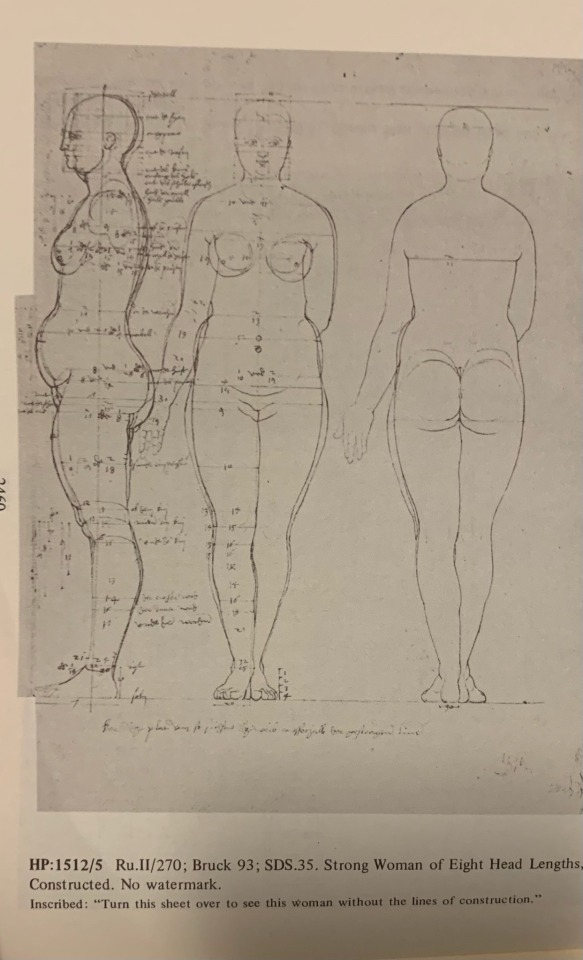"But NORMAL People's Bodies Didn't Look Like That!" ...right?
"But NORMAL People's Bodies Didn't Look Like That!" ...right?
Some of you may have seen my post about Baroque artists and their realistic depictions of human bodies as having skin and fat.
I've had a lot of negative and frankly fatphobic comments on that post, calling the people in the paintings "fat" and "obese," mostly along the lines of this:
"It's because the artists are depicting rich people, who were fat and lazy. Normal people didn't look like that!"
The idea, of course, is that these artists wouldn't have ever drawn bodies that looked like those in the Baroque paintings, if they weren't painting super-rich people that stuffed themselves with food all day.
Supposedly. We'll see how well that holds up.
Today I was in the library looking at a collection of drawings by Albrecht Dürer, and learned that in the early 1500's, Dürer tried to put together essentially a "how-to-draw" book, showing how to draw people. His work was controversial, because of his technique of "constructing" figures using rules about proportions. (A quick and easy method of inventing realistically proportioned bodies out of thin air? Cheating!!)
However, in his "constructed" drawings, Dürer had to figure out how to handle the range of variety in bodies, and ended up breaking down how to create a variety of body types in correct proportions.
I'm showing the women, to contrast with the post on Baroque paintings. Here are some of his drawings that I thought y'all should take a look at.
These are a couple of his more "average" women—the one on the left is from his drawing book, and the one on the right is one of his drawings.


Here's a "strong woman" and "A very strong, stout woman"


This is what he refers to as a "stout woman."


Here's where it gets interesting: this is what Albrecht Dürer refers to as a "peasant-type" woman

^That. That's what a "peasant" body type looks like.
He labeled this one "A peasant woman of 7 head lengths"

in case you missed it: this figure drawing by a guy in the 1500's is literally labeled as being of a peasant woman! this is what a "peasant woman" body type looks like!
He did draw similar amounts of thinner figures, but they're not particularly emphasized over the "Strong" and "Stout" figures. Nor is there exactly a "default" figure. He's just...going over the range of variations that there are?
Here's another "stout woman," covered in notes on how to draw the proportions:


now that's too technical for me to make any sense of but
this was in the 16th century!! This body type was apparently not incredibly rare in the 16th century. This body type was important enough for you to be able to draw, as an artist, in the 16th century to be handled in detail in a 16th century artist's drawing advice
In conclusion: yes this is just what people look like, yes it's important to know how to draw fat bodies, even this dude from the early 1500's is telling you so, Die Mad About It
all of this is from "The complete drawings of Albrecht Dürer" by Walter L. Strauss
More Posts from Frauwaz and Others
In an effort to avoid supporting megacorporations, I shall now be posing questions directly to tumblr that I would otherwise have googled.
Se acaba de filtrar el post de alguien por tener la palabra clave «Luke» y es la primera vez que al abrirlo se trataba del Lucas evangelista y no del trotacielos.

thankful to Dracula Daily for teaching me that this Hark a Vagrant comic is literally exactly what happens in the book

I laughed way too hard at this
I hope this has been pointed out already, but I think it’s important for you to know that Doug from Our Flag Means Death is played by Tim Heidecker
who some of you might know better as…the Free Real Estate guy

but anyway, that’s not why I’m making this post.
this is why I’m making this post:
Doug, looking at the empty place in the family that Stede left behind:

you’re welcome
what happens when two dramatic bitches like Geralt and Aragorn visit the same tavern on the same night and there’s only one corner table for them to brood at in a solitary fashion, would they take turns or share a booth while simply refusing to acknowledge each other’s existence
When the fighter is in charge of problem-solving

-
 detlillemennesket reblogged this · 3 weeks ago
detlillemennesket reblogged this · 3 weeks ago -
 eternalparadisearchive reblogged this · 3 weeks ago
eternalparadisearchive reblogged this · 3 weeks ago -
 thisiseye reblogged this · 1 month ago
thisiseye reblogged this · 1 month ago -
 sixllage reblogged this · 1 month ago
sixllage reblogged this · 1 month ago -
 bonesofarthistory reblogged this · 1 month ago
bonesofarthistory reblogged this · 1 month ago -
 lots-of-little-pink-clouds reblogged this · 1 month ago
lots-of-little-pink-clouds reblogged this · 1 month ago -
 frmewrk liked this · 1 month ago
frmewrk liked this · 1 month ago -
 indiana212 liked this · 1 month ago
indiana212 liked this · 1 month ago -
 pastelsapphy reblogged this · 1 month ago
pastelsapphy reblogged this · 1 month ago -
 the-squeaky-junk-drawer reblogged this · 1 month ago
the-squeaky-junk-drawer reblogged this · 1 month ago -
 littlefaefeather liked this · 1 month ago
littlefaefeather liked this · 1 month ago -
 cursed--alien reblogged this · 1 month ago
cursed--alien reblogged this · 1 month ago -
 totally-a-writer reblogged this · 1 month ago
totally-a-writer reblogged this · 1 month ago -
 m0th-b0nes liked this · 1 month ago
m0th-b0nes liked this · 1 month ago -
 holesmovingcastle reblogged this · 1 month ago
holesmovingcastle reblogged this · 1 month ago -
 lamplightjuniper reblogged this · 1 month ago
lamplightjuniper reblogged this · 1 month ago -
 timelordlullaby liked this · 1 month ago
timelordlullaby liked this · 1 month ago -
 rainbow-smite reblogged this · 1 month ago
rainbow-smite reblogged this · 1 month ago -
 basicallyinsanelyboring reblogged this · 1 month ago
basicallyinsanelyboring reblogged this · 1 month ago -
 hooodieeeeee liked this · 1 month ago
hooodieeeeee liked this · 1 month ago -
 audioandart liked this · 1 month ago
audioandart liked this · 1 month ago -
 flipcitrus liked this · 1 month ago
flipcitrus liked this · 1 month ago -
 heythereeren reblogged this · 1 month ago
heythereeren reblogged this · 1 month ago -
 heythereeren liked this · 1 month ago
heythereeren liked this · 1 month ago -
 stolenswingset reblogged this · 1 month ago
stolenswingset reblogged this · 1 month ago -
 stolenswingset liked this · 1 month ago
stolenswingset liked this · 1 month ago -
 catalllo reblogged this · 1 month ago
catalllo reblogged this · 1 month ago -
 n1ghtmeri liked this · 1 month ago
n1ghtmeri liked this · 1 month ago -
 laserlope-foundarock reblogged this · 1 month ago
laserlope-foundarock reblogged this · 1 month ago -
 that-notrussian reblogged this · 1 month ago
that-notrussian reblogged this · 1 month ago -
 that-notrussian liked this · 1 month ago
that-notrussian liked this · 1 month ago -
 milkpopsicleofdoom reblogged this · 1 month ago
milkpopsicleofdoom reblogged this · 1 month ago -
 milkpopsicleofdoom liked this · 1 month ago
milkpopsicleofdoom liked this · 1 month ago -
 secretlyhuntokar liked this · 1 month ago
secretlyhuntokar liked this · 1 month ago -
 safetyqualifiedminnow reblogged this · 1 month ago
safetyqualifiedminnow reblogged this · 1 month ago -
 muggle-the-hat liked this · 1 month ago
muggle-the-hat liked this · 1 month ago -
 wind-chime-system liked this · 1 month ago
wind-chime-system liked this · 1 month ago -
 long-horns--sharp-teeth liked this · 1 month ago
long-horns--sharp-teeth liked this · 1 month ago -
 tittysuckersworld reblogged this · 1 month ago
tittysuckersworld reblogged this · 1 month ago -
 tittysuckersworld reblogged this · 1 month ago
tittysuckersworld reblogged this · 1 month ago -
 tittysuckersworld liked this · 1 month ago
tittysuckersworld liked this · 1 month ago -
 ambriel-angstwitch liked this · 1 month ago
ambriel-angstwitch liked this · 1 month ago -
 illmamnim-spamming reblogged this · 1 month ago
illmamnim-spamming reblogged this · 1 month ago -
 illmamnim-spamming liked this · 1 month ago
illmamnim-spamming liked this · 1 month ago -
 jup1tersparx reblogged this · 1 month ago
jup1tersparx reblogged this · 1 month ago -
 silver-tounges-and-golden-lies reblogged this · 1 month ago
silver-tounges-and-golden-lies reblogged this · 1 month ago -
 fe3lthethunder reblogged this · 1 month ago
fe3lthethunder reblogged this · 1 month ago -
 fe3lthethunder liked this · 1 month ago
fe3lthethunder liked this · 1 month ago -
 circledinredink reblogged this · 1 month ago
circledinredink reblogged this · 1 month ago





